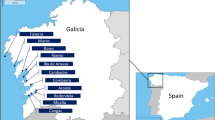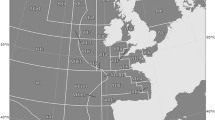Abstract
Purpose
European pilchard captures constitute an important source of income for the Portuguese fishing sector. This raw material is used for a varied range of final seafood products, such as canning, fresh seafood consumption or bait for other fisheries. The Portuguese purse seining fleet, which concentrates most of the pilchard landings, has recently obtained the Marine Stewardship Council certification scheme, demonstrating the effort of the fleet to comply with sustainable fishing practices. However, this scheme does not consider the human inputs to the fishery, such as fuel consumption or the use of other materials and resources. Consequently, life-cycle methods, such as Life Cycle Assessment (LCA), have arisen to provide a thorough assessment of the environmental profile of fishing fleets. In the current study, LCA is combined with Data Envelopment Analysis (DEA), a management tool, in order to understand the eco-efficiency of the individual vessels that compose this fleet.
Methods
A 5-step LCA + DEA method, previously used to assess resembling vessel samples, was used to examine the efficiency of 20 purse seiners in the northern Portugal for years 2011 and 2012. Individual Life Cycle Inventories (LCIs) were gathered for each vessel to perform, thereafter, the Life Cycle Impact Assessment (LCIA). DEA matrices were generated based on the LCI in order to obtain the efficiency values for each unit. Finally, based on the efficiency projections provided by the DEA model, a new LCIA was performed for inefficient vessels in order to calculate the potential environmental benefits of operating at higher levels of efficiency.
Results and discussion
The average efficiency of the fleet in the two different years of assessment was slightly above 60 %. Moreover, individual vessels showed a fairly low standard deviation across the 2 years of assessment, demonstrating that units with higher levels of efficiency tend to maintain these values through the analysed window. In fact, this result, given its strong correlation with fuel use, appears to have relation with the existence of a certain level of “skipper effect”. Important environmental benefits, mainly linked to the optimisation of fuel resources, could be attained if inefficient vessels were to operate efficiently, especially in terms of two main impact categories: climate change and fossil depletion.
Conclusions
The results in this study confirm that fishing small-pelagic fish shows low energy intensity as compared to other fisheries. However, despite this worldwide tendency, the use of LCA + DEA confirms that substantial improvements in terms of optimising energy and material inputs, as well as in reducing environmental impacts, can be attained in these fishing fleets.







Similar content being viewed by others
Notes
One of the main features of DEA matrices is the metrics that are assumed. These can either be radial, in which collective improvement calculations among inputs and outputs are considered, or non-radial, when individual improvement calculations within each input and output dimension are taken into consideration (Cooper et al. 2007).
References
Almeida C, Vaz S, Cabral H, Ziegler F (2014) Environmental assessment of sardine (Sardina pilchardus) purse seine fishery in Portugal with LCA methodology including biological impact categories. Int J Life Cycle Assess 19:297–306
Anderson J, Carvalho N, Contini F, Virtanen J (2012) Scientific, technical and economic Committee for fisheries. The 2012 Annual Economic Report on the EU fishing fleet (STECF-12-10). Joint Res Cent Sci Techn Rep. doi:10.2788/40549
Avadí A, Vázquez-Rowe I, Fréon P (2014) Eco-efficiency assessment of the Peruvian anchoveta steel and wooden fleets using the LCA + DEA framework. J Clean Prod 70:118–131
Banker R, Charnes A, Copper W (1984) Some models for estimating technical and scale inefficiencies in data envelopment analysis. Manag Sci 30:1078–1092
Belo S, Silva M, Dias A, González-García S, Arroja L (2013) Life cycle assessment of sardine captures by purse seiners in Portugal. Energy for sustainability 2013. Sustainable Cities: Designing for People and the Planet: Coimbra, 8 to 10 September 2013
Carrera P, Porteiro C (2003) Stock dynamic of the Iberian sardine (Sardina pilchardus. W.) and its implication on the fishery off Galicia (NW Spain). Sci Mar 67:245–258
Cooper WW, Seiford LM, Tone K (2007) Data envelopment analysis: a comprehen- sive text with models, applications, references and DEA-Solver software. Springer
EMEP/EEA (2009) Air pollutant emissions inventory guidebook, available at http://www.eea.europa.eu//publications/emep-eea-emission-inventory-guidebook-2009
Ernest Y (2009) Analyse de l’approvisionnement et de la commercialisation des produits de la pêche et de l’aquaculture dans l’Union Européenne. Tome 3 – Études de cas filières. European Commission. DirectorateGeneral forMaritime Affairs and Fisheries [in French]
Fréon P, Bouchon M, Mullon C, García C, Ñiquen M (2008) Interdecadal variability of anchoveta abundance and overcapacity of the fishery in Peru. Prog Oceanogr 79:401–412
Fréon P, Avadí A, Chávez RAV, Ahón FI (2014) Life cycle assessment of the Peruvian industrial anchoveta fleet: boundary setting in life cycle inventory analyses of complex and plural means of production. Int J Life Cycle Assess 19:1068–1086
Frischknecht R, Jungbluth N, Althaus HJ, et al (2007) Overview and methodology. Ecoinvent report No. 1. Swiss Centre for Life Cycle Inventories. Duebendorf, Switzerland
Gaertner D, Pagavino M, Marcano J (1999) Influence of fishers’ behaviour on the catchability of surface tuna schools in the Venezuelan purse-seiner fishery in the Caribbean Sea. Can J Fish Aquat Sci 56:394–406
Goedkoop M, Heijungs R, Huijbregts M, et al. (2009) ReCiPe 2008. A life cycle impact assessment method which comprises harmonised category indicators at the midpoint and the endpoint level. Report I: characterisation. Ministry of Housing, Spatial Planning and Environment (VROM), Ministry of Housing, Spatial Planning and Environment (VROM). www.lcia-recipe.info
Hauschild MZ, Goedkoop M, Guinée J et al (2013) Identifying best existing practice for characterization modeling in life cycle impact assessment. Int J Life Cycle Assess 18:683–697
Hospido A, Tyedmers P (2005) Life cycle environmental impacts of Spanish tuna fisheries. Fish Res 76:174–186
ICES (2012) ICES Advice 2012. Sardine in divisions VIIIc and IXa. Book 7
ICES (2013) Bay of Biscay and Atlantic Iberian waters. Sardine in divisions VIIIc and IXa. Advice for 2013. International Council for the Exploration of the Sea – ICES. Available at: http://ices.dk/sites/pub/Publication%20Reports/Advice/2013/2013/sar-soth.pdf
INE (2011) Estatísticas da pesca 2011, Instituto Nacional de Estatística, Lisboa, Portugal, (2012)
INE (2012) Estatísticas da pesca 2011. Instituto Nacional de Estatística, Lisboa
Iribarren D, Vázquez-Rowe I, Moreira MT, Feijoo G (2010a) Further potentials in the joint implementation of life cycle assessment and data envelopment analysis. Sci Total Environ 408:5265–5272
Iribarren D, Vázquez-Rowe I, Hospido A, Moreira MT, Feijoo G (2010b) Estimation of the carbon footprint of the Galician fishing activity (NW Spain). Sci Total Environ 408:5284–5294
Iribarren D, Vázquez-Rowe I, Hospido A, Moreira MT, Feijoo G (2011) Updating the carbon footprint of the Galician fishing activity (NW Spain). Sci Total Environ 409:1609–1611
ISO (2006a) ISO 14040. Environmental Management – Life Cycle Assessment – Principles and Framework. International Organization for Standardization
ISO (2006b) ISO 14044. Environmental management—life cycle assessment—requirements and guidelines. International Organization for Standardization
ISO (2012) ISO 14045. Environmental management—ecoefficiency assessment of product systems—principles, requirements and guidelines. International Organization for Standardization
Kortelainen M (2008) Dynamic environmental performance analysis: a Malmquist index approach. Ecol Econ 64:701–715
Kuosmanen T, Kortelainen M (2005) Measuring eco-efficiency of production with data envelopment analysis. J Ind Ecol 9:59–72
Kuosmanen T, Kortelainen M (2007) Eco-efficiency analysis of consumer durables using absolute shadow prices. J Prod Anal 28:57–69
MADRP (2010) Ministério da Agricultura, do Desenvolvimento Rural e das Pescas, Portaria n° 251/2010 de 4 de maio [in Portuguese]
Martín-Cerdeño VJ (2010) Consumo de pescado en España. Diferencias en función de las características del consumidor. MERCASA. Distribución y consumo (in Spanish)
Mendes HV, Borges MF (2006) A sardinha no século XX: capturas e esforço de pesca. Relat. Cient. Téc. IPIMAR, Série digital n° 32, 20 p. ISSN: 1645-863X (in Portuguese)
MSC (2013) Surveillance report Portuguese sardine purse seine fishery. Marine Stewardship Council. (Retrieved from: http://www.msc.org/track-a-fishery/fisheries-inthe-program/certified/north-east-atlantic/portugal-sardine-purse-seine/assessmentdownloads-1/20120112_RPT_SR.pdf, Last accessed: September 5th 2014)
MSC (2014) Marine Stewardship Council. Available at: www.msc.org (Last accessed: September 20th 2014)
Parker R, Tyedmers P (2014) Fuel consumption of global fishing fleets: current understanding and knowledge gaps. Fish Fish. doi:10.1111/faf.12087
PRè Consultants (2014) PRè Consultants. Available at: www.pre-sustainability.com (Last accessed: September 20th 2014)
Ramos S, Vázquez-Rowe I, Artetxe I, Moreira MT, Feijoo G, Zufía J (2011) Environmental assessment of the Atlantic mackerel (Scomber scombrus) season in the Basque Country. Increasing the timeline delimitation in fishery LCA studies. Int J Life Cycle Assess 16:599–610
Ramos S, Vázquez-Rowe I, Artetxe I, Moreira MT, Feijoo G, Zufía J (2014) Operational efficiency and environmental impact fluctuations of the Basque trawling fleet using LCA + DEA methodology. Turk J Fish Aquat Sci 14:77–90
Ruttan LM, Tyedmers PH (2007) Skippers, spotters and seiners: analysis of the “skipper effect” in US menhaden (Brevoortia spp.) purse-seine fisheries. Fish Res 83:73–80
Saitech-inc (2014) Saitech-inc.com. http://www.saitech-inc.com/Products/Prod-DSP.asp
Silva A, Skagen DW, Uriarte A et al (2009) Geographic variability of sardine dynamics in the Iberian Biscay region. ICES J Mar Sci 66:495–508
Squires D, Kirkley J (1999) Skipper skill and panel data in fishing industries. Can J Fish Aquat Sci 56:2011–2018
Tacon A, Metian M (2009) Fishing for aquaculture: non-food use of small pelagic forage fish—a global perspective. Rev Fish Sci 17:305–317
Thrall R (1996) Duality, classification and slacks in DEA. Ann Oper Res 66:109–138
Tone K (2001) A slacks-based measure of efficiency in data envelopment analysis. Eur J Oper Res 130:498–509
Vázquez-Rowe I, Benetto E (2014) The use of a consequential perspective to upgrade the utility of Life Cycle Assessment for fishery managers and policy makers. Mar Policy 48:14–17
Vázquez-Rowe I, Iribarren D (2014) Review of life-cycle approaches coupled with Data Envelopment Analysis: launching the CFP + DEA method for energy policy making. The Scientific World Journal, Article ID 813921
Vázquez-Rowe I, Villanueva-Rey P, Moreira MT, Feijoo, G (2013) The role of consumer purchase and post-purchase decision-making in sustainable seafood consumption. A Spanish case study using carbon footprinting. Food Policy 41:94-102
Vázquez-Rowe I, Tyedmers P (2013) Identifying the importance of the “skipper effect” within sources of measured inefficiency in fisheries through data envelopment analysis (DEA). Mar Policy 38:387–396
Vázquez-Rowe I, Iribarren D, Moreira MT, Feijoo G (2010a) Life cycle assessment of horse mackerel fisheries in Galicia (NW Spain): comparative analysis of two major fishing methods. Fish Res 106:517–527
Vázquez-Rowe I, Iribarren D, Moreira MT, Feijoo G (2010b) Combined application of life cycle assessment and data envelopment analysis as a methodological approach for the assessment of fisheries. Int J Life Cycle Assess 15:272–283
Vázquez-Rowe I, Iribarren D, Hospido A, Moreira MT, Feijoo G (2011) Computation of operational and environmental benchmarks within selected Galician fishing fleets. J Ind Ecol 15:776–795
Vázquez-Rowe I, Hospido A, Moreira MT, Feijoo G (2012) Best practices in life cycle assessment implementation in fisheries. Improving and broadening environmental assessment for seafood production systems. Trends Food Sci Technol 28:116–131
Vázquez-Rowe I, Villanueva-Rey P, Hospido A, Moreira MT, Feijoo G (2014) Life cycle assessment of European pilchard (Sardina pilchardus) consumption. A case study for Galicia (NW Spain). Sci Total Environ 475:48–60
Ziegler F, Winther U, Hogne ES, Emanuelsson A, Sund V, Ellingsen H (2013) The carbon footprint of Norwegian seafood products on the global seafood market. J Ind Ecol 17:103–116
Ziegler F, Hornborg S, Green B et al. (2014) Expanding the concept of sustainable fisheries: measuring the sustainability of seafood supply chains using a life cycle perspective. Fish Fish, under review
Acknowledgments
The authors belong to the Galician Competitive Research Group GRC 2013–032. Dr. Ian Vázquez-Rowe wishes to thank the Galician Government for the financial support (I2C postdoctoral student grants programme). Dr. Sara González-García would like to express her gratitude to the Galician Government (DOG number 62, pages 9405–9410, 1 April 2013) for a Postdoctoral Research Fellowship at the University of Aveiro (Portugal), and to the Spanish Ministry of Economy and Competitivity (Grant reference JCI-2012-11898) for the financial support.
Author information
Authors and Affiliations
Corresponding author
Additional information
Responsible editor: Peter Saling
Rights and permissions
About this article
Cite this article
González-García, S., Villanueva-Rey, P., Belo, S. et al. Cross-vessel eco-efficiency analysis. A case study for purse seining fishing from North Portugal targeting European pilchard. Int J Life Cycle Assess 20, 1019–1032 (2015). https://doi.org/10.1007/s11367-015-0887-6
Received:
Accepted:
Published:
Issue Date:
DOI: https://doi.org/10.1007/s11367-015-0887-6




